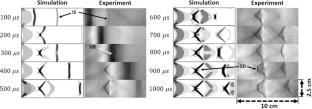脉冲产生的高速流动中单相和两相液滴的破裂
摘要
采用实验和数值模拟的方法,研究了开放激波管在脉冲产生的高速气流的影响下,液滴的有氧破碎。在高韦伯数条件下,研究了水和两相纳米流体(分别由\({{\hbox {Al}}_{2}{\hbox {O}}_{3}}\)和\({{\hbox {TiO}}_{2}}\)纳米颗粒分散体组成)在20和40 wt高负载水中的破裂情况%, respectively. Droplet breakup is visualized using high-speed imaging in the experimental setup, where an open-ended shock tube generates impulsive high-speed flow impinging on a droplet held stationary using an acoustic levitator. Axisymmetric simulations using the volume-of-fluid technique are conducted to capture the gas dynamics of the flowfield and droplet deformation at the initial stages. Fluid droplets are subject to a transient flowfield generated by the open-ended shock tube, characterized by a propagating incident shock wave, a recirculating vortex ring, and standing shock cells. Droplet breakup for all fluids proceeds through an initial flattening of the droplet followed by generation of a liquid sheet at the periphery in the presence of a curved detached shock front at the leading edge. The breakup appears to follow a sheet stripping process whereby stretched ligaments undergo secondary atomization through viscous shear. Mist generated in the wake of the droplet appears to expand laterally due to the unconstrained expansion of the high-speed gas jet. The breakup morphology of droplets for all fluids appears consistent with previous observations using conventional shock tubes. Lateral deformation of the coherent droplet mass is observed to be higher for nanofluids as compared to water. This is attributed to higher viscosity and Ohnesorge number of nanofluid droplets, which results in delayed breakup and increased lateral stretching. When plotted as a function of non-dimensionalized time, the same effects are also attributed to generate the highest non-dimensional velocities for the \({{\hbox {TiO}}_{2}}\) nanofluid, followed by \({{\hbox {Al}}_{2}{\hbox {O}}_{3}}\) nanofluid, and water, which mirrors the order of viscosity and Ohnesorge number for the three fluids. An area of spread, which can be interpreted as a measure of dispersion, plotted as a function of non-dimensionalized time also shows the highest value for the \({{\hbox {TiO}}_{2}}\) nanofluid, followed by \({{\hbox {Al}}_{2}{\hbox {O}}_{3}}\) nanofluid, and water. Overall, current results indicate that droplet breakup for two-phase fluids appears to be similar to those for single-phase fluids with effectively higher viscosity. Furthermore, an open-ended shock tube proves to be an effective tool to study droplet aerobreakup, with some differences observed in the droplet wake due to the unconfined expansion of gas flow.

Aerobreakup of fluid droplets under the influence of impulsively generated high-speed gas flow using an open-ended shock tube is studied using experiments and numerical simulations. Breakup of millimeter-sized droplets at high Weber numbers was analyzed for water and two-phase nanofluids consisting of dispersions of \({{\hbox {Al}}_{2}{\hbox {O}}_{3}}\) and \({{\hbox {TiO}}_{2}}\) nanoparticles in water with high loading of 20 and 40 wt%, respectively. Droplet breakup is visualized using high-speed imaging in the experimental setup, where an open-ended shock tube generates impulsive high-speed flow impinging on a droplet held stationary using an acoustic levitator. Axisymmetric simulations using the volume-of-fluid technique are conducted to capture the gas dynamics of the flowfield and droplet deformation at the initial stages. Fluid droplets are subject to a transient flowfield generated by the open-ended shock tube, characterized by a propagating incident shock wave, a recirculating vortex ring, and standing shock cells. Droplet breakup for all fluids proceeds through an initial flattening of the droplet followed by generation of a liquid sheet at the periphery in the presence of a curved detached shock front at the leading edge. The breakup appears to follow a sheet stripping process whereby stretched ligaments undergo secondary atomization through viscous shear. Mist generated in the wake of the droplet appears to expand laterally due to the unconstrained expansion of the high-speed gas jet. The breakup morphology of droplets for all fluids appears consistent with previous observations using conventional shock tubes. Lateral deformation of the coherent droplet mass is observed to be higher for nanofluids as compared to water. This is attributed to higher viscosity and Ohnesorge number of nanofluid droplets, which results in delayed breakup and increased lateral stretching. When plotted as a function of non-dimensionalized time, the same effects are also attributed to generate the highest non-dimensional velocities for the \({{\hbox {TiO}}_{2}}\) nanofluid, followed by \({{\hbox {Al}}_{2}{\hbox {O}}_{3}}\) nanofluid, and water, which mirrors the order of viscosity and Ohnesorge number for the three fluids. An area of spread, which can be interpreted as a measure of dispersion, plotted as a function of non-dimensionalized time also shows the highest value for the \({{\hbox {TiO}}_{2}}\) nanofluid, followed by \({{\hbox {Al}}_{2}{\hbox {O}}_{3}}\) nanofluid, and water. Overall, current results indicate that droplet breakup for two-phase fluids appears to be similar to those for single-phase fluids with effectively higher viscosity. Furthermore, an open-ended shock tube proves to be an effective tool to study droplet aerobreakup, with some differences observed in the droplet wake due to the unconfined expansion of gas flow.

 求助内容:
求助内容: 应助结果提醒方式:
应助结果提醒方式:


